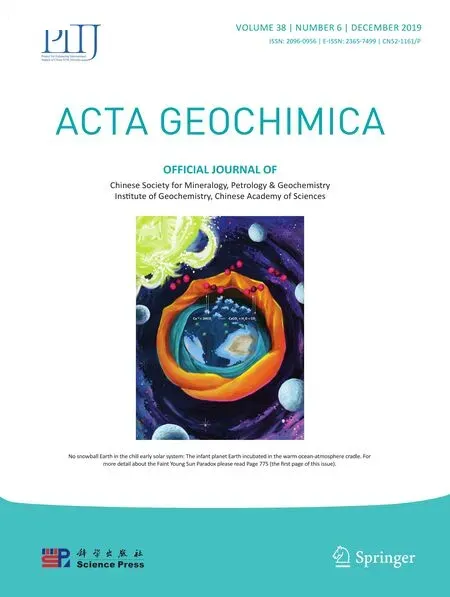Petrogenesis,geochemistry and geological significance of Paleocene Granite in South Gangdese,Tibet
Chengzhi Li·Wenguang Yang·Lidong Zhu·Zhen Yang·Limin Lin·Xin Su·Hongliang Zhang
Abstract The Gangdese magmatic belt,located along the southern margin of the Lhasa terrane,plays a critical role in understanding the tectonic framework associated with the Indian–Asian slab collision.In this paper,a chronology of zircon U–Pb and geochemical analysis of the rock of the Cuobulaguo granitic mass in the southern of the Gangdese,Tibet,revealed a series of results.The results show that the LA-ICP-MS monzonitic granite zircon U–Pb ages are 61–59 Ma,which corresponds to the same period as the magmatic arc of the southern limit of Gangdese.In terms of geochemical composition,the granite is rich in ω(SiO2)70.09% to 72.64%, with a high ω(Al2O3) 14.40% to 15.99%,a low ω(TiO2)0.08%to 0.24%,ω(MgO)0.41%to 0.76%, ω(Fe2O3 T)6.82% to 29.9%, ω(P2O5)0.07% to 0.12%,and ω(CaO)1.06%to 1.75%.The granite mainly belongs to the high-K calc-alkaline series.The light rare earth element (LREE) content of skeletal granite is between 133.69×10-6 ~226.64×10-6 and the heavy rare earth element (HREE) content is between 17.36×10-6 and 32.11×10-6.LREE/HREE is between 5.05 and 7.83.It is enriched in light rare earth elements(LREE)and large ion lithophile elements,such as Rb,K,U,etc.,depletes high field strength elements,such as P,Nb,and Ta, and has the geochemical composition of arc magmatic rocks. In addition, the aluminum saturation index(A/CNK=1.06 to 1.11) of Cuobulaguo granite,belongs to I-type granite. The comprehensive analysis showed that with the beginning of the collision between the Indian–Asian continental,the subduction ocean plate was separated from the continental plate due to gravity,resulting in an increase in the asthenosphere,which made partial fusion of the lithospheric mantle.It invaded the bottom of the lower crust,which in turn induced a partial melting of the lower crust to form granite.
Keywords Petrogenesis·Zircon U–Pb dating·
1 Introduction
The Qinghai-Tibet Plateau is known as the‘‘roof of the world’’and is an ideal place to study the dynamics of the continent(Yin and Harrison 2000;Mo et al.2009a;Xu et al.2011;Zhang et al.2017).The Lhasa Terrane contains essential information,as well as more collisions and orogenic evolution of the Neo-Tethys oceanic(Mo et al.2003,2007).Acidic volcanic rocks in southern Gangdese are typical,which provide a collisional evolution of the Indian–Asia continent,and subduction to the north of the New-Tethys slab provide evidence (Chung et al.2003,2005,2009;Dong et al.2008;Chu et al.2006,2011;Mo et al.2005,2009a,b;Pan et al.2006;Hou et al.2008;Ji et al.2009a,b;Xu 2010;Ma et al.2017;Zhu et al.2008,2011,2015,2017;Zhang et al.2013a,b,2017;Tang et al.2015;Wang et al.2015;Sun et al.2017).However,both the nature of the Early Eocene magmatic rocks within the belt and their tectonic history are still debated.Early work believed that the Palcoccne granitoids were caused by the subduction of the Neo-Tethys oceanic slab(Searle et al.1987;Xu et al.2011;Ji et al.2016).More recent work systematically studied the Linzizong volcanic rocks and,through this system,thought that the collision caused the subduction of the Neo-Tethyan oceanic slab roll-back and break-off(Mo et al.2003,2005,2008;Xu 2010).In recent years,a large number of scholars have carried out research on the magma evolution of the Gangdese rock foundation.The magmatic rock belt of Gangdese is a complex rocky base formed by multistage magmatism.The granite in this region consists mainly of magmatic arc-shaped rocks,which show the characteristics of the mantle with losses or the area of the main source of the crust(Chung et al.2003).In addition,many scholars have discussed the timing of the collision between the Indian–Asia continent and the geochemical characteristics of the magmatic rocks. Most researchers believe that the collision time of the Indian–Asia continent is the Early Eocene(~55 Ma)(Ji et al.2009a,2016;Xu et al.2011;Donaldson et al.2013;Zhu et al.2015;Hu et al.2015,2016).However,some scholars believe that this event occurred at approximately 45 Ma(Wang 2017).In addition,the genesis of the magmatic activity in the southern belt of Gangdese is usually due to subduction in the by Neo-Tethys oceanic and the magma that underlies the collision between Indian and Asia continent.The‘‘break-off’’and‘‘roll-back’’of the Neo-Tethys oceanic slab are considered the general overview of deep magmatism in the southern Gangdese belt(Wen et al.2008a,b;Ji et al.2012,2016;Wang 2016;Wang et al.2015;Zhu et al.2015;Ma et al.2017).
In this study,we present zircon U–Pb ages of granite rock from the Cuobulaguo in the southern margin of the Lhasa country.Then,we analyzed petrogenesis,source of magma and the geodynamic configuration of granite.The new information is beneficial to our understanding of the genesis and formation of magma in the southern Gangdese belt and also provides new information about the collision process of the Indian–Asia continent.
2 Geological background
Qinghai-Tibet Plateau,respectively,from north to south to Jinsha Suture Zone(JSSZ),Bangong-Nujiang Suture Zone(BNSN)and Yarlung-Tsangpo Suture Zone(YZSN)for the delineation of Songfan-Ganzi Terrane,Qiangtang Terrane,Lhasa Terrane, and Himalayan Terrane (Fig.1a). The Lhasa Terrane is also known as the‘‘Gangdese Terrane’’(Mo et al.2005;Pan et al.2006;Zhu et al.2008),with an east–west longitude of about 2500 km and a north–south width of about 100 to 300 km.The Gangdese terrane can be divided into the northern,central,and southern subterranes,bounded by the Shiquanhe-Nam Tso Me′lange Zone(SNMZ)and Luobadul-Milashan Fault(LMF)(Zhu et al.2006,2008)(Fig.1b).The north of Gangdese and the south of Gangdese are characterized by juvenile crust.Central Gangdese is mainly characterized by ancient crust(Pan et al.2006;Zhu et al.2008,2011,2015).In the central subterrane of Gangdese Terrane,Carboniferous-Permian meta-sedimentary sequences and Lower Cretaceous volcano-sedimentary sequences are intruded by widespread Mesozoic granite(~210–90 Ma)(Alle`gre and Rousseau 1984;Zhu et al.2011),Paleocene-Eocene granite(Ji et al.2009a,b,c),and volcanic rocks of the Linzizong Volcanic Succession(Mo et al.2007).This new study focuses on the southern subterrane of Gangdese(Fig.1b).This basement has undergone the subduction of the Neo-Tethys oceanic slab and the India-Asia continental collision(Yin and Harrison 2000;Mo et al.2005;Chu et al.2006)However,in the eastern part of Gangdese southern subterrane,Early Paleozoic granites were discovered(Dong et al.2005),suggesting that the old crystalline basement may be present locally in this subterrane.South of the Gangdese,the Cretaceous magmatic rocks of the Lower Mesozoic develop mainly at the base of Cretaceous rocks-nege′nico of Gangdese and in the volcanic rocks of the Linzizong Paleo′geno.Recent research indicates,the magmatism was generated mainly between the Upper Cretaceous and the Paleogene after the collision between an Indian–Asian continent and subduction to the north of the Neo-Tethys oceanic slab due to the severity.
The granitic region of Cuobulaguo is located on the southern Gangdese terrane.The rock mass was produced in an irregular rock mass from east to west with an exposed area of about 60 km2(Fig.1c).The rock mass is divided into marginal phase and central phase.The intrusive strata are mainly the Yeba(J2–3y)and Chumulong(K1c)formations.The contact zone often has a contact metamorphism,such as silicification,horn lithification,and skarnisation phenomenon.The brown mass of the fault is better in the field(Fig.2a).The main rock types are medium-finegrained monzonitic granites with a massive structure and a fine-grained granitic structure(Fig.2b,c).The main minerals include quartz(28%to 30%),K-feldspars(30%to 38%),plagioclase(25%to 30%),and biotite(5%to 10%)and hornblende(less than 2%),apatite minerals,metals and other minerals with particle sizes between 2 and 6 mm(Fig.2d,e).Quartz has a granular shape and is distributed unevenly.It is often replaced by alkali feldspar and plagioclase.Plagioclase is a semi-formed self-formed plate,with many double crystals or polycrystalline channels,and its surface is sometimes altered by chlorite.The K-feldspars have a semi-automatic shape,a plate shape and two transparent crystals in the form of a card.It is composed mainly of striped feldspar and feldspar,and its particle size is 0.2 to 6 mm.A small amount of quartz is replaced by potassium feldspar,which contains a structure and a slight alteration of the clay.The biotite is brown and scaly,with a small amount of meteorite and chlorite alteration,distributed between plagioclase,alkali feldspar and quartz particles,and has a low green mud and petrochemical.
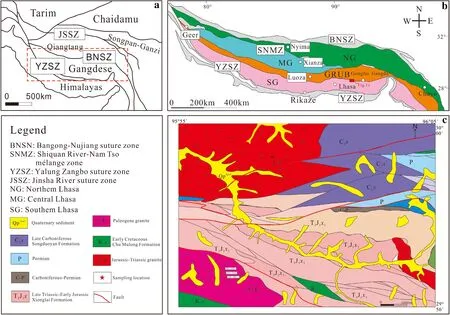
Fig.1 The geological map of the Tibet Plateau(a)and the Gangdese tectonic unit(b)(according to Zhu et al.2009)and the geological distribution of the Cuobulaguo granite(c)
3 Analytical methods
The zircon samples were separated and selected in Langfang City,Hebei Province,Yuheng Rock Mine Technology Services Co.,Ltd.,after the sample was milled and washed,the standard technology of separation of heavy liquids and Magnetic was used to extract the zircon.Samples of zircon and cathodoluminescence photomicrography were completed at Beijing Zirconium Leading Technology Co.,Ltd.,and the zircon particles without glass or cracks were selected under a binocular microscope,and the zircon was applied on the double-sided tape.It was fixed with epoxy resin and polished until the inside of the grain was exposed.Prior to analysis,the surface was cleaned with 3%HNO3to remove any lead contaminants.The zirconium particles were polished to half the original particle size to obtain zirconium cathode photoluminescence(CL)images.The Zircon U–Pb dating analysis was performed by Wuhan Shangpu Analysis Technology Co.,Ltd.using the LA-ICPMS method.The GeolasPro laser ablation test system used in the experiment included a MicroLas optical system and a COMPexPro 102 ArF laser excimer 193 nm with a laser ablation beam and a frequency of 32 μm and 10 Hz,respectively.In the process of laser ablation,helium was used as the carrier gas for the ablation material,and argon as the compensation gas.The zirconium U–Pb and the trace elements were corrected.By fractionation of isotopes and trace elements according to the zircon standard 91,500 and the glass material standard NIST610 as external standards.Data processing was performed using the ICPMS DataCal software(Liu et al.2010).The age harmonic map of the U–Pb zircon and the calculated weighted average age were calculated using Isoplot/Ex_ver3(Ludwig 2003).Relative error 1σ of individual test data, for zircon206Pb/238U Age >1000 Ma with207Pb/206Pb,otherwise with206Pb/238U of age.The results of the test are shown in Supplementary materials Table 1.
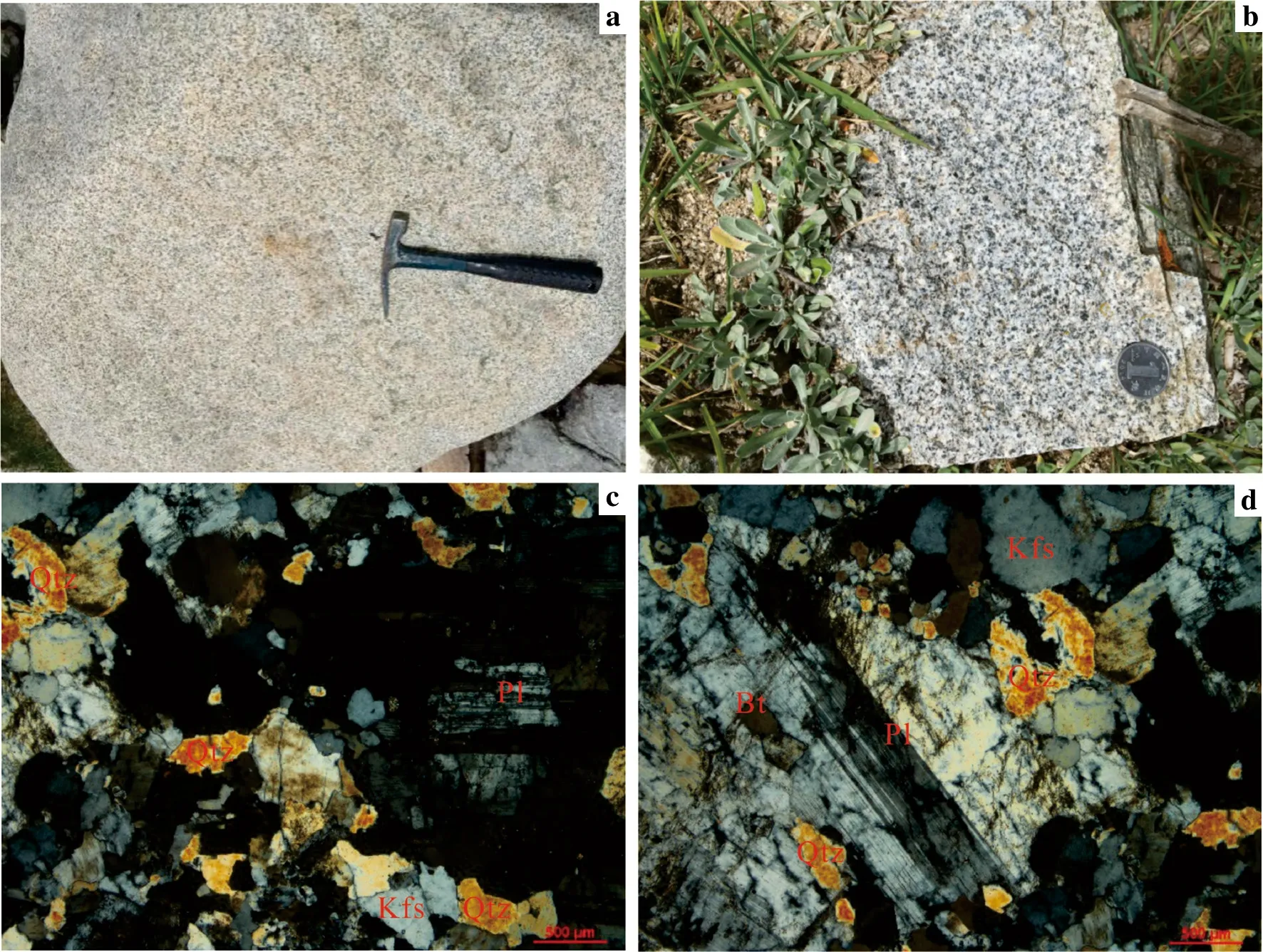
Fig.2 Cuobulaguo granite outcrop(a,b)and microscopic photos(c,d)Qtz,quartz;Pl,plagioclase;Kfs,potassium feldspar;Bt,biotite
The content analysis of major-elements,trace-elements,and rare-earth-elements was completed at the Laboratory of Isotope Geochemistry,Guangzhou Institute of Geochemistry.The analysis accuracy of the main elements was better than 2%.The glass cake was made by alkali fusion method and analyzed by Rigaku 100e X-ray fluorescence spectrometer(XRF);Trace elements using Perkin-Elmer Elan 6000 inductively coupled plasma mass spectrometer(ICP-MS)analysis,the accuracy of trace elements in the sample is less than 10×10-6better than 10%,the content is more than 10×10-6analysis accuracy of better than 5%;The rare earth element analysis accuracy of the sample is better than 5%.The detailed analysis process and related parameters can be seen(Liu and Liu 1996),and the test results are shown in Supplementary materials Table 2.
4 Analysis results
4.1 Zircon U-Pb geochronology
The zircon separated from the Cuobulaguo granite were analyzed to obtain precise geological ages.CL images of zircon grains are shown in Fig.3.The white circles represent the domains of U–Pb citations.The zircon particles in the sample(D0861-N1)are mainly edue`dric and have long to short prismatic shapes with average crystalline lengths of 65–170 μm and a length to width ratio of up to 2:1 or 3:1.Most zircons in CL images were transparent and colorless to slightly brown,with oscillatory zoning typical of magmatic growth.Some zircon particles had a nuclear boundary structure;the zircon nucleus was darker in color and the oscillatory zoning was not developed.25 dating analyzes were performed in 25 zircons,with the exception of one point error and two harmonics less than 90%,and the other 22 zircons had a Th content of 36.8×10-6to 590×10-6,a content of 40.9×10-6to 1715×10-6,Th/U ratios ranging from 0.36 to 2.63,greater than 0.1,indicating a magmatic origin;U–Pb analyses of 22 granitic zircons(D0861-N1)gave a206Pb/238U concordance of 56±6 Ma at 195±3 Ma (Supplementary materials Table 1),most of which were located in or near the harmonic line; Zircon D0861-N1-01 apparently had an advanced age of206Pb/238U of 195±3 Ma,which may be the age at which zircon was captured.The remaining 21 zircons of206Pb/238U are 56±6 to 67±3 Ma,and the weighted mean age was 61.3±1.4 Ma(Fig.3b).Therefore,the D0861-N1 sample was generated in the Paleocene,which represents the crystalline age of the rock mass.
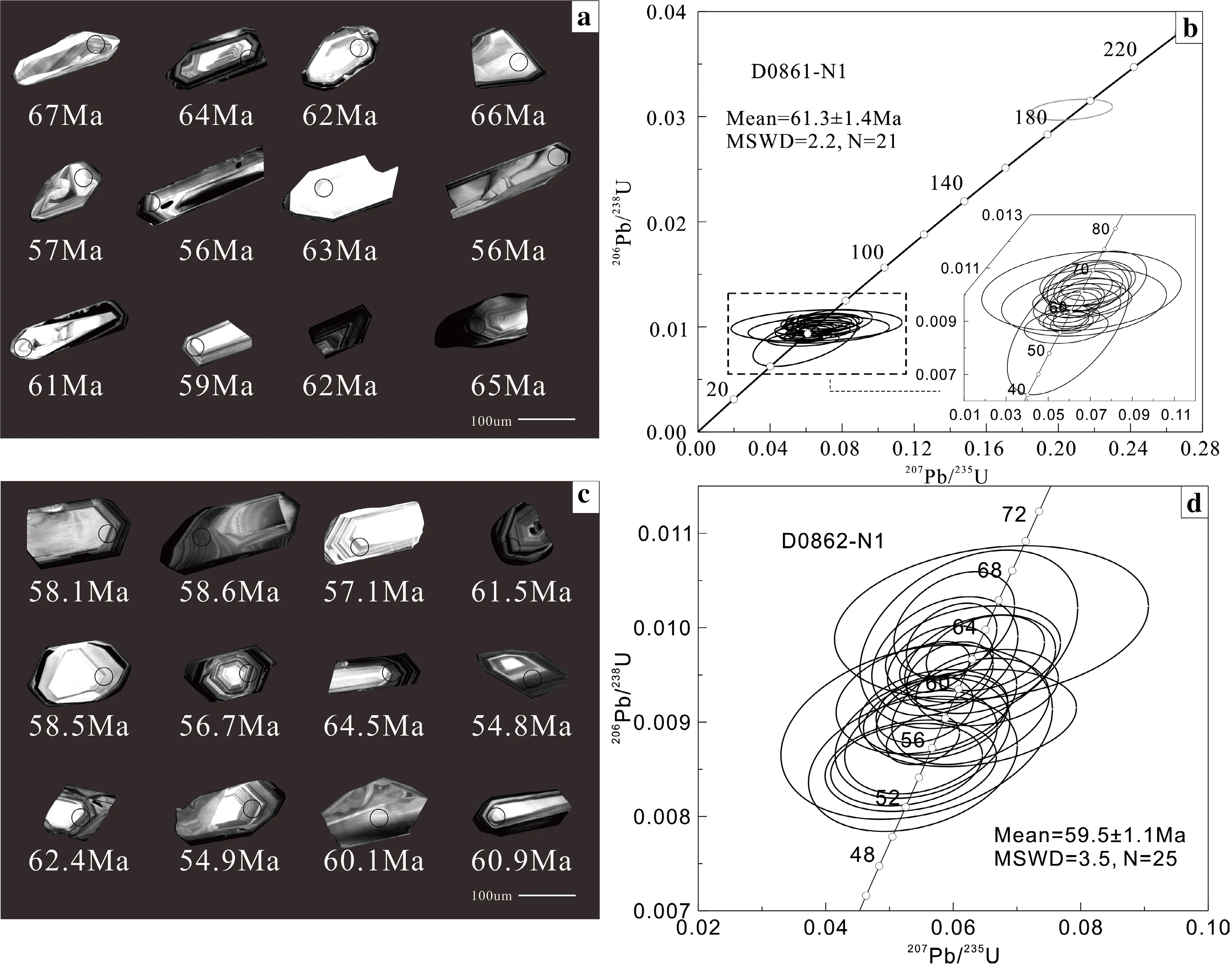
Fig.3 Zircon cathode luminescence image(a,c)and U–Pb harmonic age diagram(b,d)
The zircon particles of the sample(D0862-N1)were mostly euhedral prismatic crystals with a length of 80–230 μm,a width of 30–110 μm,and length-to-widthratios of up about 2:1 to 3:1.Most zircons in the CL images were transparent and colorless to slightly brown and display oscillatory zoning typical of magmatic growth.25 dating analyses were performed on 25 zircons.The zircon Th content of the measured was 45.2×10-6to 481×10-6,U content was 69.4×10-6to 1111×10-6,Th/U ratios ranging from 0.31 to 2.41,indicating a magmatic origin;The 25 zircon U–Pb analyses from sample(D0862-N1) yielded concordant206Pb/238U ages of 54.9±1.1 to 64.5±2.1 Ma with a weighted mean206Pb/238U age of 59.5±1.1 Ma(Fig.3d).These ages were mostly located on or adjacent to the harmonic line.The Paleocene represents the age of early magmatic diagenesis.
4.2 Whole rock geochemistry
4.2.1 Major elements
The principal component compositions of the granuloid assemblages of the Cuobulaguo pluton are listed in Supplementary materials Table 2.Granitioids have a relatively wide range of SiO2.The SiO2content of the Cuobulaguo pluton varies from 70.09%to 72.64%,which is characterized by a high content of ω(Al2O3)14.40%to 15.99%,low ω(TiO2)0.08%to 0.24%,ω(MgO)0.41%to 0.76%,ω(Fe2O3T)6.82%to 29.9%,ω(P2O5)0.07%to 0.12%and ω(CaO)1.06%to 1.75%.On a total alkali and silica TAS diagram,the samples plot mostly in the granite fields and show a sub-alkaline affinity(below dotted line)(Fig.4),which is fundamentally consistent with the results of the identification of the slice.The DI(differential index)of the sample was 73.28 to 89.35,Mg#(magnesium index)(6.70 to 13.60).These rocks have Na2O and K2O contents of 3.86%to 4.75%and 3.51%to 5.55%,respectively,with(Na2O+K2O)from 7.91%to 9.44%,with the K2O/Na2O ratios of 0.74 to 1.43 and a value average of 1.05.Moreover,the samples from the granitoid rocks were mainly plotted in the field of the high K Calc-alkaline and shoshonite series on the SiO2versus K2O diagram(Fig.5a).On the A/NK versus A/CNK diagram(Fig.5b),most of the samples were weak peraluminous.The similarity is also shown on the Harker diagrams,the samples show good linear relationships between SiO2and major oxides(Fig.6).
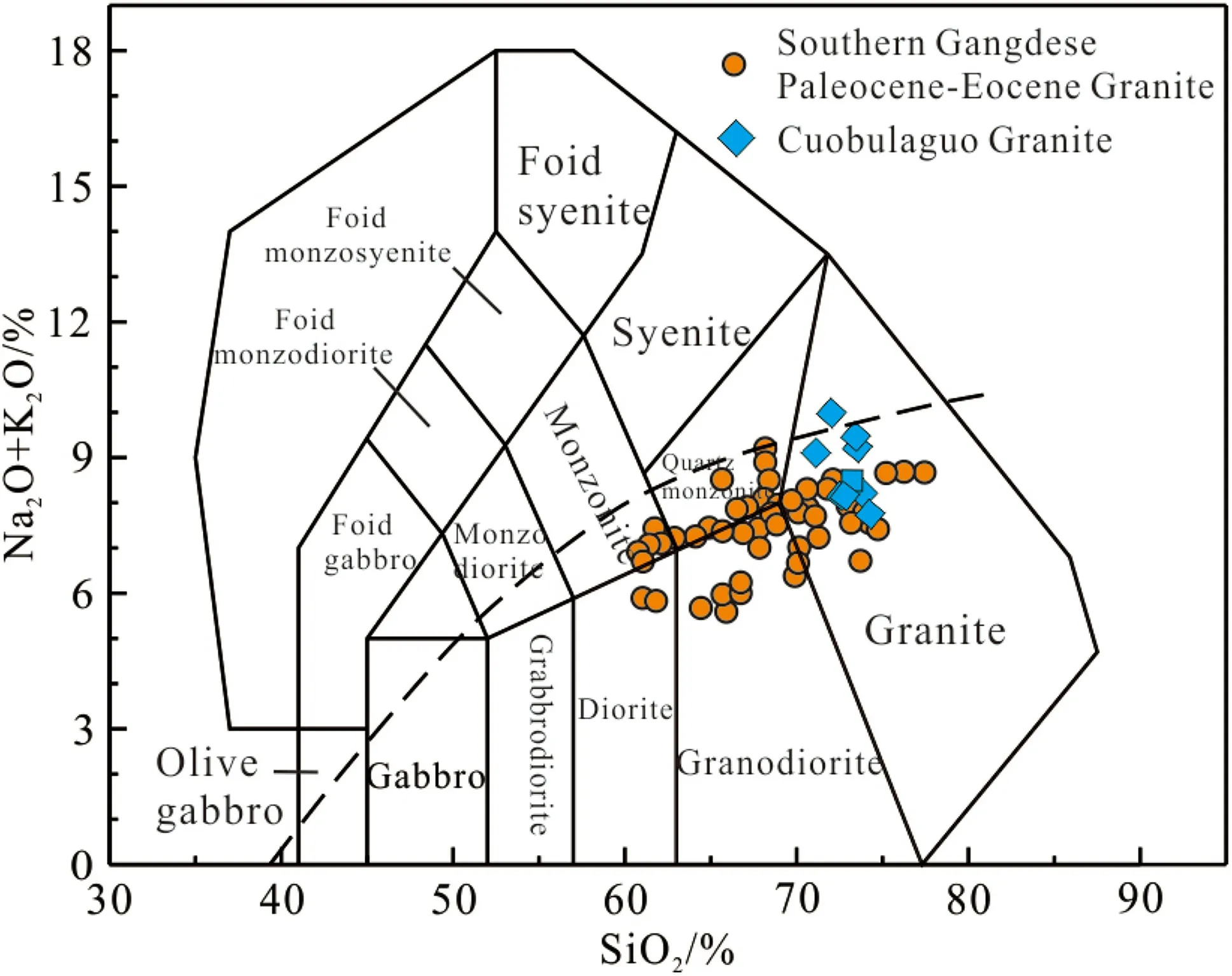
Fig.4 TAS diagram of the Cuobulaguo granite (according to Middlemost 1994).Other Eocene granite in the southern Gangdese terrane are from Xu(2010)
4.2.2 Rare earths and trace elements
All analytical results are listed in Supplementary materials Table 2. The chondrite-normalized rare earth element patterns suggest that these rocks have similar geochemical characteristics(Fig.7a).The sample total REE contents of 151.21×10-6to 257.66×10-6, the mean value is 227.75×10-6,slightly higher than the upper crust average total(210×10-6)(He et al.2005).They are characterized by an enrichment of light rare earth elements(LREEs)and a depletion of heavy rare earth elements(HREEs), LREE/HREE is 5.05–7.83, (La/Yb)Nof 4.48–7.93 and the average value was 6.2.All samples have moderately-strong Eu negative anomalies(δEu of 0.35 to 0.51),showing a very consistent distribution pattern with the upper crust,which is consistent with the presence of plagioclase or potassium feldspar cumulates.The primitive mantle normalized trace elements pattern show that samples are relatively enriched in the large ion lithophile elements(LILEs),such as Rb,Th,and K.Among the highfield-strength elements(HFSE),the samples show negative Nb,P,Ba,Ti anomalies(Fig.7b).These geochemical features are similar to those of the South Gangdese Eocene granite, such as the Qushui granite masses, Namulin granite masses and Xietongmen granite masses(Xu 2010;Meng et al.2018).
5 Discussion
5.1 Petrogenesis
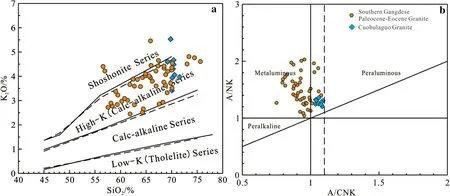
Fig.5 Chemical classification diagram of the Cuobulaguo granite:K2O versus Si2O diagram(a according to Rickwood 1989)and A/NK versus A/CNK diagram(b according to Peccerillo 1976).Other Eocene granite in the southern Gangdese terrane are from Xu(2010)
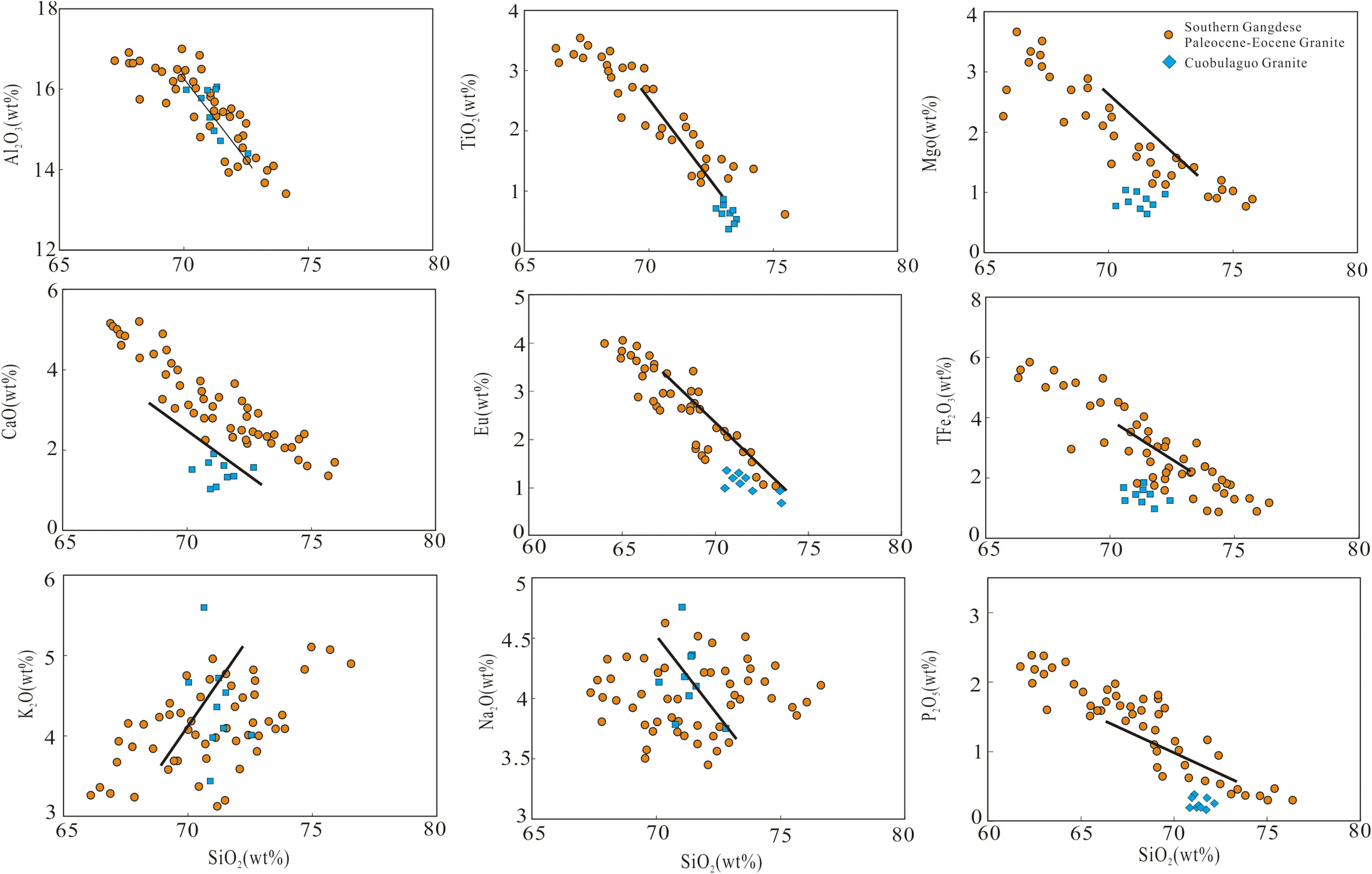
Fig.6 Harker diagram of the Cuobulaguo granite.Other Eocene granite in the southern Gangdese terrane are from Xu(2010)

Fig.7 Chondrites-normalized map of rare earth element patterns(a)and primitive mantle-normalized trace elements patterns(b)of the Cuobulaguo granite(standardized values according to Sun and Mcdonough 1989).Other Eocene granite in the southern Gangdese terrane are from Xu(2010)
The granitoid rocks are divide into A,I,M,and S types based on their geochemical and mineral compositions(Chappell and White 1974;Chappell 1999;Bonin 2007).In general,alkaline melanocratic minerals(e.g.,aegirine and riebeckite)are regarded as typical minerals of A-type granite.Superfluous muscovite,sillimanite,and cordierite are associated with S-type granite.The I-type granite was characterized by hornblende and the absence of peraluminous minerals(Whalen and Chappell 1988).The aluminum saturation index A/CNK of the granite in the study area was less than 1.1 and the A/CNK-A/NK low series of overalumina.The types of aluminous and peraluminous rock were generally considered decompression and fusion heating in the context of shortening of the earth’s crust at the beginning of the collision or in the context of rapid rise of the crust and detachment of the crust extension(Zhu et al. 2006). The Cuobulaguo pluton had high SiO2(70.09%–72.64%)and high Na2O and K2O(3.86%–4.75%;3.51%–5.55%).At the same time,it had low P2O5(0.07%–0.12%),low MgO(0.41%–0.76%),and low TiO2(0.08%–0.24%).In addition,all samples had moderately-strong Eu negative anomalies(δEu of 0.35 to 0.51),and were enriched in the large ion lithophile elements(LILEs),such as Rb,Th,and K.Among the high-field-strength elements(HFSE),the sample negative Nb,P,Ba,Ti anomalies(Fig.7b).The granite in our study mainly consists of plagioclase,quartz,and K-feldspar with minor amounts of hornblende and biotite(Fig.2d,e),but lack muscovite and other Al-rich minerals.The samples have A/CNK <1.1,but the samoles were hornblende-bearing granite.P had a very low solubility in aluminous or slightly aluminous solutions,which decreases as the degree of differentiation(Pichavant et al.1992).The P2O5contents decrease with the increase of the SiO2contents(Fig.6),which adjusts to the trend of evolution of the I-type granite;Its characteristics are important criteria for distinguishing I-type granite(Chappell and White 1992).Therefore,this petrological composition is characteristic of I-type granite rather than S-type granite.In addition,our field observations of rock assemblages and the granite’s low Cr content of 5.94 to 12.03 ppm indicate that the granite did not form by partial melting of an ophiolite, which also excludes M-type granites.This is also confirmed by plotting our samples in the geochemical discrimination diagrams in Fig.8,which show that the granite not fractioned and is an I-type granite.
5.2 Granite magma source area and evolution
Previous studies show that partial melting of the crust can produce granites in large quantities(Leake 1990).The formation of I-type granites may have two reasons:(1)The formation of I-type granites results from the partial melting of intermediate-base igneous rocks or metamorphic rocks in the crust(Chappell and Stephens 1988);(2)I-type granite formation by a mantle source during the bark melting process(Kemp et al.2007).Taking into account the regional context and the petrological characteristics,we conclude that the granite is derived from the partial melting of metamorphic rocks of the Earth’s crust.
In general,voluminous granites are usually formed by partial melting of the crust.In geochemistry,the main granitic elements of Cuobulaguo TiO2,MgO,Al2O3,CaO,MnO,K2O and Na2O have a good linear relationship with SiO2and the granite can undergo a mixture of magma(Fig.6).The loss of Cuobulaguo granite from Sr,Ba and Eu trace elements reflects the separation and crystallization of plagioclase and K-feldspar during granite formation(Qiu et al.2005).According to the Fig.8b(Lai et al.2007),Separation and crystallization of plagioclase and K-feldspar are mainly found in the diagenesis process of the Cuobulaguo pluton.
In the rare earth partitioning diagram and the microelement cobweb diagram,the granite samples were enriched in LILE of large ions(Rb,Th,U,K and Pb)and the loss of High intensity field elements(HFSE),such as Ba,P,and Ti,which had the geochemical characteristics of crust or arc magmatic rocks(Kelemen et al.1990).The geochemical characteristics of the samples indicate that the source rocks of the granite are closely related to the lower crust.In addition,the loss of Sr,P,and Ti shows to some extent the geochemical characteristics of the igneous rocks related to subduction,while the loss of Ba and Nb reflects the characteristics of the continental crust of the region of origin.Combinations of trace elements are very useful for discriminating the tectonic adjustment of magma,such as Nb/Ta,Th/Ta,Y/Nb,and La/Nb(Sun and McDonough 1989).The value of the sample in Nb/Ta was between 7.32 and 12.42,a value close to the average value of the crust and much lower than the initial melting value of the mantle and derived from it.The value of Th/Ta is 9.16 to 26.33,which is much higher than the genetic rocks of original mantle,and is relatively close to the mean value of the crust(Th/Ta=11.67,Rudnick and Gao 2003).Value of Y/Nb(<1.2),while crust genetic rocks have a value greater than 1.2(Eby 1992).The Y/Nb value of the samples in the study area is between 1.73 and 3.16,indicating that the samples are the product of the molten differentiation of the source of the crust.In addition,the ratio La/Nb of the sample was between 1.77 and 3.28,with an average value of 2.53,both greater than 1.0,which was different from the mantle.The Zr versus Zr/Sm diagram(Fig.9a)can be used to judge magmatic genesis and the samples show a positive correlation,indicating that partial melting is the main process of Cuobulaguo granitoid diagenesis.In the Nb versus Nb/Th diagram(Fig.10a),the samples have the same geochemical properties as the volcanic arcs.In the Nb/Y versus Th/Y diagram(Fig.10b),the samples are located between the Th/Nb=1 and Th/Nb=10 trends,close to the average composition of the lower crust.The low MgO and Cr content in the samples also indicated that the granite of the region had been partially melted from the material of the crust source material.In addition,according to the Fig.9b(Lai et al.2007),minerals such as plagioclase and apatite have been separated and crystallized during the process of diagenesis granite of Cuobulaguo.This was consistent with the moderately Eu negative anomalies(δEu of 0.35 to 0.51).The granite sample in the study area has fewer Mg#values(6.7–13.6),which are less than 45,indicating that the main magma does not interact with the mantle.
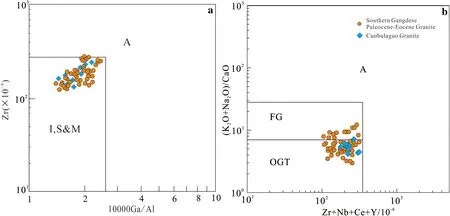
Fig.8 Zr versus 10000 Ga/Al and(K2O+Na2O)/CaO versus Zr+Nb+Ce+Y discriminant diagram of the Cuobulaguo granite(a,b according to Whalen and Chappell 1998).Other Eocene granite in the southern Gangdese terrane are from Xu(2010)
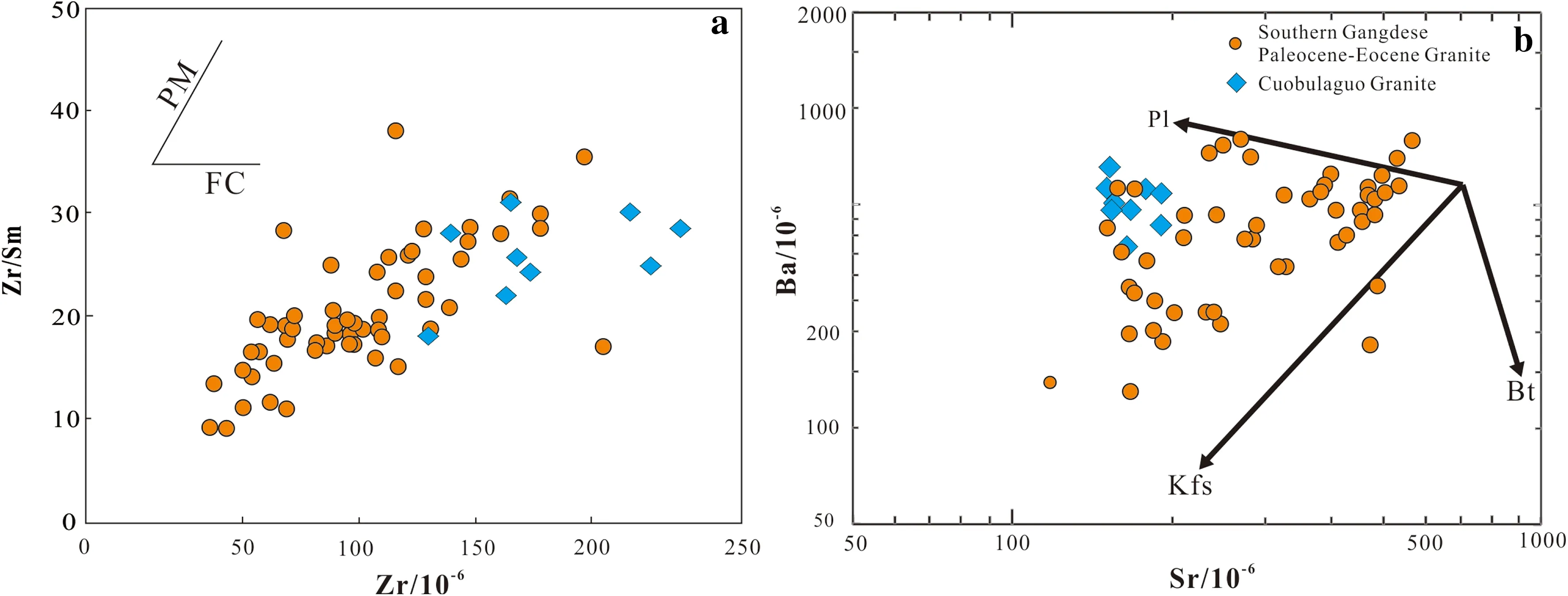
Fig.9 Schematic diagram of Zr/Sm versus Zr(a)and Ba versus Sr of the Cuobulaguo granite(according to Schiano et al.2010).Other Eocene granite in the southern Gangdese terrane are from Xu(2010)
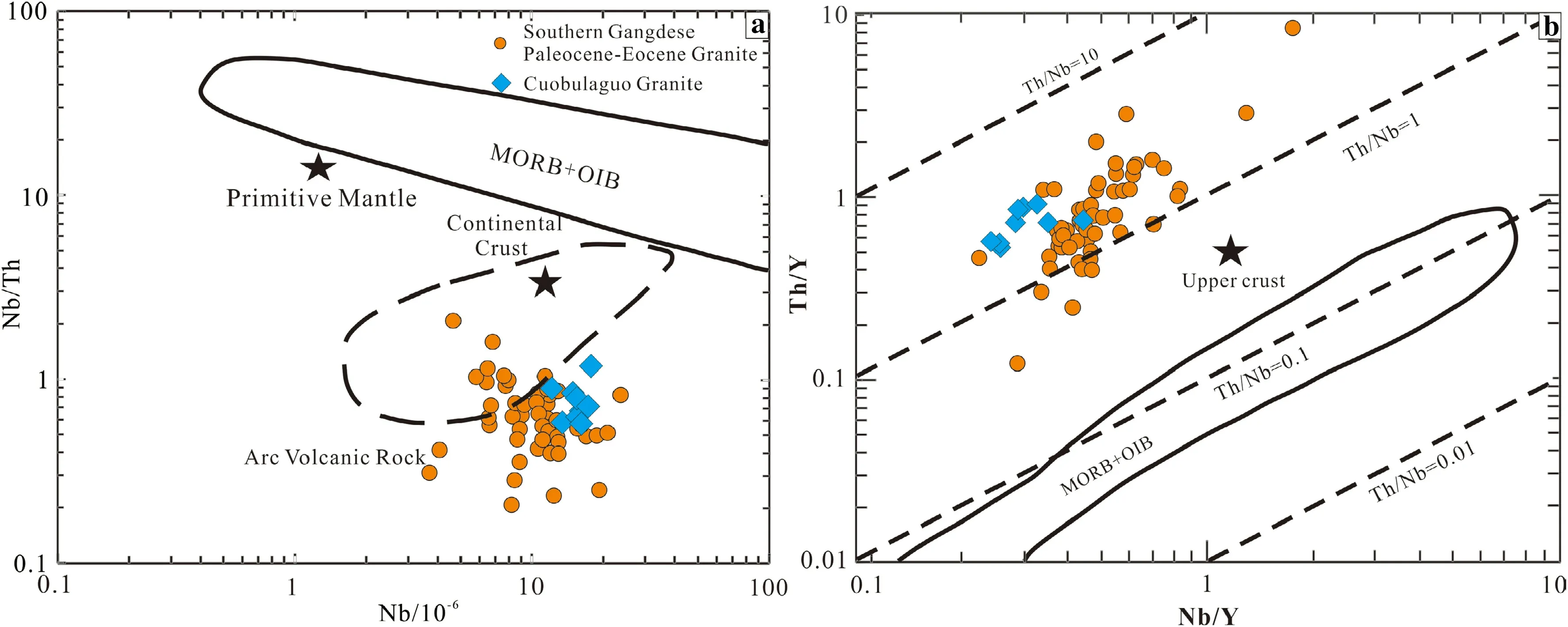
Fig.10 Nb/Th versus Nb(a)and Th/Y versus Nb/Y(b)diagrams of the Cuobulaguo granite(according to Boztug?et al.2007).Other Eocene granite in the southern Gangdese terrane are from Xu(2010)
Experiments in petrology have shown that in a wide range of temperature and pressure conditions, partial melting of the continental crust with different components would produce different types of granite magma(Skjerlie and Patin?o Douce 2002). The partial fusion of the sedimentary rocks in the crust usually produces acidic and acidic granites,while the partial fusion of the middle and basic rocks in the crust produces I-type granite basal alumina(Sisson et al.2005).Nb/Th ratio(1.1–1.3)is similar to the ratio of the source of the crust,significantly lower than the proportion of the mantle source(>15),suggesting that granite magma not be partially melted from mantle Peridotite or partially melted of basaltic magma.Al2O3/(MgO+FeOT) versus CaO/(MgO+FeOT) of the magma are related to the source material of the rock and the ratio can discriminate the source material of the intermediate-acid magma rock.Combined with the discriminant plot of the region of origin of the granite (Fig.10),Cuobulaguo granite samples fall into the partially melted sandstone of the metamorphic sandstone,indicating that it comes from the partial fusion of the metamorphic sandstone of the crust.
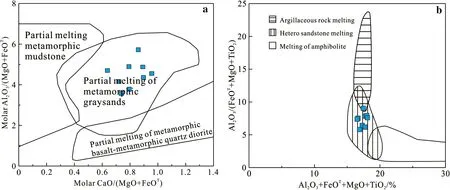
Fig.11 Distinguishing diagram of the original rock type of the Cuobulaguo granite(a according to Altherr et al.2000)(b according to Douce 1999)
In summary,the Cuobulaguo granite formation may come from the lower crust being partially melted and formed(Fig.11).
5.3 Tectonic background
Igneous rocks are commonly used to reconstruct the tectonic configuration,given the link between magma generation and plate tectonics(Winter 2001).As we all know,southern Gangdese Terrane considered the most magmatic region of the Qinghai-Tibetan plateau.Paleocene-Eocene Gangdese(65–41 Ma)is the peak of magmatic activity.Previous studies have shown that the main body of the Gangdese rock base is granite,mainly affected by the continental collision between India and Asia,the Neo-Tethy oceanic slab detachment and subduction and collision north of the basin.Himalayan-Tethys oceanic on the south side.Rupture of the Neo-Tethy oceanic slab at the beginning of the continental collision between India and Asia.To the south of Gangdese occurred large-scale calcalkaline volcanic eruptions and subsequent small-scale intrusion,forming Dianzhong formation and the Linzizong formation volcanic rocks,as well as a small amount of intrusive acidic rock(Mo et al.2005;Xu 2010;Dong 2008).Although much research has been done,there are still differences between the India-Asia continental collision and disappearance of the Neo-Tethys oceanic(Rowley 1998;Yin and Harrison 2000;Aitchison et al.2007).Lee and Lawver(1995)suggested that the India-Asia continent had a‘‘soft collision’’around 65 Ma and that a‘‘hard collision’’occurred around 45 Ma;Hou et al.(2006)considered that the India-Asia continental collisions were divided into three stages:main collision(65–41 Ma),late collision(40–26 Ma)and backward collision(25–0 Ma).Mo et al.(2007)suggested that the India-Asia continent collided around 70–65 Ma and the collision ended around 40 Ma,and the Neo-Tethys oceanic disappeared.According to the results of previous statistics(Garzanti et al.1987;Yin and Harrison 2000;Aitchison et al.2002,2007;Mo et al.2007;Najman et al.2010;Bouilhol et al.2013;Donaldson et al.2013;Hu et al.2015,2016;Yang et al.2015;Zhu et al.2015;Ding et al.2016;Meng et al.2016a,b),most researchers believe that continental collisions information Indian–Asian are from the Late Paleocene to the Early Eocene(60–55 Ma).The Cuobulaguo pluton in this study formed in 61–59 Ma,thereby providing a valuable case study for understanding the Paleocene magmatism,and limit the initial collision time of the India-Asian continental and geodynamics of the southern Gangdese subterrane.
The specific tectonic setting forms a certain type of magmatic rock,and the tectonic setting of the magmatic rock can be judged by its characteristics of geochemical composition(Dong 2008).In the discrimination of the tectonic environment,elements of high field intensity are usually selected as Nb,Y,Ta,and Yb.They have a low ion energy potential,are relatively stable during weathering,alteration,and metamorphism of rocks and,in general,do not migrate.Insensitive to reflection and separation of crystallization and assimilation,it can represent the composition of the region of origin.At the same time,we can also choose trace elements with different activities,for example, Rb/30 versus Hf versus 3Ta and Rb versus Y+Yb(Fig.12),the samples fall into the granite of the post-collision granite and volcanic arc granite,reflecting the environment of the magma formation after the collision,which may be the orogenic stage or the collision stage, reflecting the environment of Formation of the magma after the collision of Cuobulaguo,suggests that theIndian–Asian continent in the middle of the Paleocene collided.
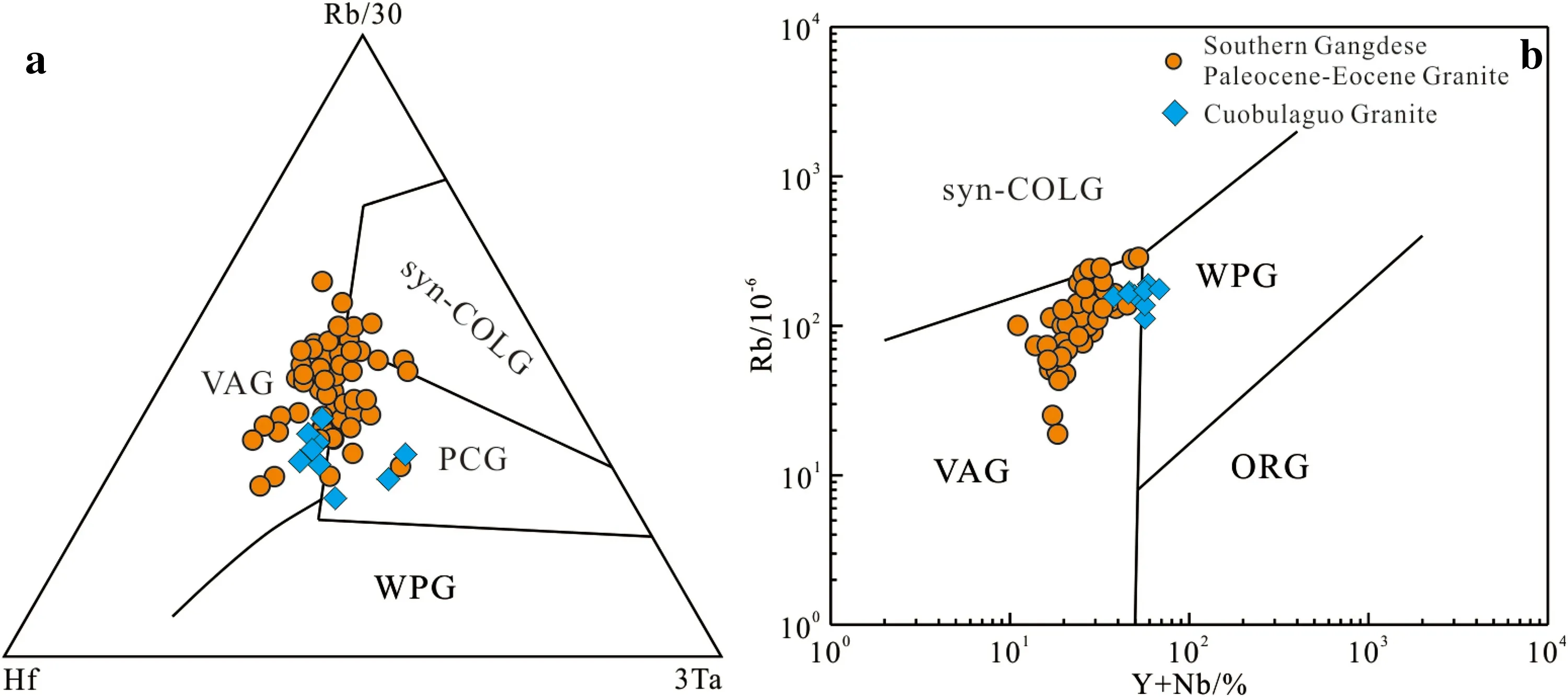
Fig.12 Discriminant diagram of Rb/30 versus Hf versus 3Ta(a according to Pearce et al.1984)and Rb versus Y+Yb(b according to Zhang et al.2008)tectonic backgrounds of the Cuobulaguo granite.Other Eocene granite in the southern Gangdese terrane are from Xu(2010)
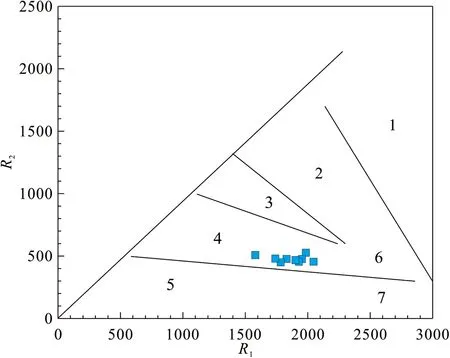
Fig.13 Discriminant diagram of the structural background of R2 versus R1 (according to Batchelor 1985). 1-Mantle plagioclase granite;2-destructive mobile plate margin(pre-collision)granite;3-post collision uplift granite;4-late orogenic granite;5-anorogenic A-type granite; 6-syn-collision(S-type) granite; 7-post orogenic A-type granite
Combined with the R2versus R1granite diagram(Fig.13),all samples are in the late orogenic granite zone,indicating that the formation environment corresponds to the granite after the collision,indicating that it may be formed in the late stage of the collision.Since the postcollision environment is relatively complex,it is not possible to distinguish its tectonic environment solely by chemical illustration.It must be considered in combination with other geological facts.The activity of the magma formed by the tectonic environment after the collision has common characteristics:mainly for high-K calc-alkaline granites,peraluminous and alkaline–alkaline granules on alkali are also more numerous,but are separated from each other;post-collisional magmatism is related to horizontal movement along the shear zone;The area of origin contains a large number of new components,newly formed volcanic rocks or sedimentary rock features.
The Cuobulaguo granites in this study were formed at 61–59 Ma.According to previous research,in the shallow low-pressure source area,the minerals are mainly plagioclase.At that time,a large number of Sr and plagioclase Ca have isomorphism and have low Sr/Y and La/Yb ratio characteristics in the molten state(Moyen 2009);In areas of deep high pressure,minerals are mainly amphiboles and garnets,and their melts have high proportions of Sr/Y and La/Yb(Zhu et al.2017);The results of the test show that the samples have a lower Sr/Y and La/Yb ratio,suggesting that the granite is formed in a shallow environment at low pressure.According to research carried out by Wang and his collaborators (2017), in the Gangdese Belt of 80–70 Ma,there are magmatic rocks with high proportions of Sr/Y and La/Yb,which indicate that the Gangdese have suffered a process similar uprising in the collision of the Andes of the Asian continent;Magmatic rocks exposed at the base of Gangdese(70–65 Ma)have begun to become rare and do not have the characteristics of a thickened lower crust.The Neo-tethyan oceanic slab can have low angle subduction before 70 Ma,and the 70–65 Ma subduction slab can rebound or be at the beginning of the collision between the Indian and Asian continents(Tian et al.2016;Li et al.2016).
After the initial continental collision between Indian and Asia,the continuous subduction of the dense Neo-Tethyan oceanic slab generated a great downward force in the floating continental lithosphere that is resistant to subduction the continued subduction(Davies and von Blanckenburg 1995).This situation of opposing forces created a strong deformation of the extension in the slab,which resulted in a narrow zone of break off and finally the detachment of the Neo-Tethyan oceanic slab at ~61 Ma.Granite production containing muscovite often marks the conversion of the tectonic environment(Hou et al.2006).The roll-back of the slab usually takes place at the end of the oceanic subduction and at the beginning of the collision between the Earth and the continent and gives way to the burial in depth of the continental slab(Brun and Faccenna 2008).Consequently,at 61 Ma,the Neo-Tethys oceanic slab suffered a roll-back of the slab,causing upwelling of mantle material.Provide a sufficient source of heat for the material of the lower crust,melting the lower crust to form an early granite.
Based on the previous analysis,the tectonic framework formed by the Cuobulaguo granite may be the post-collision crust extension stage and belongs to the post-collision environment.This paper estimates that the initial moment of the continental collision between India and Asia is no later than 61 Ma.With the onset of the continental collision between India and Asia,the Neo-Tethys oceanic slab subduced by subduction is separated from the continental plate by gravity,causing the upwelling of the asthenosphere,thereby inducing partial melting of the lithospheric mantle to produce intermediate-acid magma.And bottoming into the bottom of the lower crust, and then inducing partial melting of the lower crust to form Cuobulaguo granitic.
6 Conclusion
1. The U–Pb ages of the zircon LA-ICP-MS in the Cuobulaguo granites are 61.3±1.4 ~59.5±1.1 Ma, indicating formation during the Middle Paleocene.
2. The Cuobulaguo granite belongs to I-type granite.The granite samples were enriched in LILE of large ions(Rb,Th,U,K,and Pb)and the loss of High-intensity field elements(HFSE),such as Ba,P and Ti.It has geochemical characteristics of crust or arc magmatic rocks.
3. The collision of the Indian–Asia continent and break off of the Neo-Tethys oceanic slab was responsible for the generation of the Cuobulaguo granite and,more generally,for the Paleocene magmatism in the southern Gangdese subterrane.
Acknowledgements The fieldwork was guided by Professor.Zhu Lidong and Dr.Yang Wenguang.They participated in the fieldwork,which werehelped by Yang Zhen,Lu Zhiyou,Su Xin,Li Limin,Zhang Hongliang,Mai Yuanjun,and Hu Juncheng at University of Chinese Academy of Sciences.Valuable comments from reviewers on this article are appreciated.
- Acta Geochimica的其它文章
- Whole-rock geochemistry of Tertiary sediments of Mizoram Foreland Basin,NE India:implications for source composition,tectonic setting and sedimentary processes
- An experimental study on dynamic coupling process of alkaline feldspar dissolution and secondary mineral precipitation
- Isotherm and kinetic studies on the adsorption of humic acid molecular size fractions onto clay minerals
- REE geochemistry of gangue minerals and their geological significance in the Muli antimony ore deposit in Yunnan,China
- Petrography and tectonic provenance of the Miocene Surma Group in parts of the Naga-Manipur hills,in and around Nungba,Northeast India
- Study on Late Cretaceous-Cenozoic exhumation of the Yanji area,NE China:insights from low-temperature thermochronology

